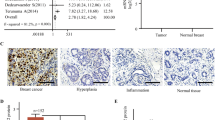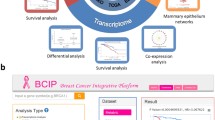Abstract
Background
Tissue factor (TF) is a glycoprotein which binds factor VIIa. The TF-VIIa complex serves as a potent initiator of the coagulation pathways. TF, an immediate early gene, may also play a role in cell growth. Expression of TF was correlated with some types of cancers.
Materials and Methods
Normal, immortalized, and tumor human mammary epithelial cells were used in the experiments. The differential display (DD) technique was used to identify genes differentially expressed in the cells. TF expression patterns were examined by Northern blot analysis, immunofluorescence staining of cultured cells, and immunohistochemical staining in human cryostat sections.
Results
In a 5-way display, an amplified polymerase chain reaction (PCR) product was found in normal and immortalized human mammary epithelial cells but not in the breast cancer cells. The PCR fragment was cloned and sequenced. The result showed that the fragment was identical to human tissue factor. Northern blot analysis showed that expression level of tissue factor mRNA remained high in growing, quiescent, and senescent normal mammary epithelial cells. Immunofluorescence staining also confirmed tissue factor expression pattern in the cell lines tested. Immunohistochemical staining showed that tissue factor was expressed in the normal luminal and myoepithelial cells of some ducts but not others. No staining was observed in invasive carcinoma cells. However, myoepithelial cell staining was seen in some residual ductal structures in invasive tumors.
Conclusions
This study shows the use of DD to reveal the loss of TF expression pattern in human breast cancer cell lines. Immunohistochemical staining results showed breast carcinoma cells expressed little TF, if any, suggesting that TF is not required for breast tumor cell invasion. The results also indicated that TF expression was independent of the proliferation status of the expressing cells. The expression pattern of TF may be a meaningful marker in the development of breast cancer.




Similar content being viewed by others
References
Bach R, Nemerson Y, Konigsberg WH. (1981) Purification and characterization of bovine tissue factor. J. Biol. Chem. 256: 8324–8336.
Nemerson Y. (1988) Tissue factor and hemostasis. Blood 71: 1–8.
Edgington TS, Mackman N, Brand K, Ruf W. (1991) The structural biology of expression and function of tissue factor. Thromb. Haemostas. 66: 67–79.
Davie EW, Fujikawa K, Kisiel W. (1991) The coagulation cascade: Initiation, maintenance, and regulation. Biochemistry 30: 10363–10370.
Hartzell S, Ryder K, Lanahan A, Lau LF, Nathans D. (1989) A growth factor-responsive gene of murine BALB/c3T3 cells encodes a protein homologous to human tissue factor. Mol. Cell. Biol. 9: 2567–2573.
Drake TA, Morrissey JH, Edgington TS. (1989) Selective cellular expression of tissue factor in human tissues. Am. J. Pathol. 134: 1087–1097.
Ruf W, Edgington TS. (1994) Structural biology of tissue factor, the initiator of thrombogenesis in vivo. F.A.S.E.B. J. 8: 385–390.
Sack GH, Levin J, Bell WR. (1977) Trousseau’s syndrome and other manifestations of chronic disseminated coagulopathy in patients with neoplasm: Clinical, pathophysiologic and therapeutic features. Medicine 56: 1–37.
Rickles FR, Levine M, Edwards RL. (1992) Hemostatic alterations in cancer patients. Cancer Metast. Rev. 11: 237–248.
Rao LWM. (1992) Tissue factor as a tumor procoagulant. Cancer Metast. Rev. 11: 249–266.
Kwaan HC. (1992) The plasminogen-plas-min system in malignancy. Cancer Metast. Rev. 11: 291–311.
Honn KV, Tang DG, Crissman JD. (1992) Platelets and cancer metastasis: A causal relationship? Cancer Metast. Rev. 11: 325–351.
Callander NS, Varki N, Rao LVM. (1992) Immunohistochemical identification of tissue factor in solid tumors. Cancer 70: 1194–1201.
Costantini V, Zacharski LR, Memoli VA, Kisiel W, Kudryk BJ, Rousseau SM. (1991) Fibrinogen deposition without thrombin generation in primary human breast cancer tissue. Cancer Res. 51: 349–353.
Sturm U, Luther T, Albrecht S, Flossel C, Grossmann H, Muller M. (1992) Immunohistological detection of tissue factor in normal and abnormal human mammary glands using monoclonal antibodies. Virchows Arch. A. Path. Anat. Histopath. 421(2): 79–86.
Band V, Sager R. (1989) Distinctive traits of normal and tumor-derived human mammary epithelial cells expressed in a medium that supports long-term growth of both cell types. Proc. Natl. Acad. Sci. 86: 1249–1253.
Band V, Zajchowski D, Kulesa V, Sager R. (1990) Human papilloma virus DNAs immortalize normal human mammary epithelial cells and reduce their growth factor requirements. Proc. Natl. Acad. Sci. 87: 463–467.
Soule HD, Maloney TM, Wolman SR, et al. (1990) Isolation and characterization of a spontaneously immortalized human breast epithelial cell line, MCF-10. Cancer Res. 50: 6075–6086.
Zajchowski D, Band V, Pauzie N, Tager A, Stampfer M, Sager R. (1988) Expression of growth factors and oncogenes in normal and tumor-derived human mammary epithelial cells. Cancer Res. 48: 7041–7047.
Liang P, Pardee AB. (1992) Differential display of eukaryotic messenger RNA by means of the polymerase chain reaction. Science 257: 967–970.
Sager R, Anisowicz A, Neveu M, Liang P, Sotiropoulou G. (1993) Identification by differential display of alpha 6 integrin as a candidate tumor suppressor gene. F.A.S.E.B. J. 7: 964–970.
Liang P, Averboukh L, Pardee AB. (1993) Distribution and cloning of eukaryotic mRNAs by means of differential display: Refinements and optimization. Nucleic Acids Res. 21: 3269–3275.
Morrissey JM, Fair DS, Edgington TS. (1988) Monoclonal antibody analysis of purified and cell-associated tissue factor. Thromb. Res. 52: 247–261.
Scarpati EM, Wen D, Broze GJ Jr, et al. (1987) Human tissue factor: cDNA sequence and chromosome localization of the gene. Biochemistry 26: 5234–5238.
Muller M, Flossel C, Haase M, et al. (1993) Cellular localization of tissue factor in human breast cancer cell lines. Virchows Arch. B. Cell. Pathol. 64: 265–269.
Zou Z, Anisowicz A, Hendrix MJC, et al. (1994) Maspin, a serpin with tumor-suppressing activity in human mammary epithelial cells. Science 263: 526–529.
Ranganathan G, Blatti SP, Subramaniam M, Fass DN, Maihle NJ, Getz MJ. (1991) Cloning of murine tissue factor and regulation of gene expression by transforming growth factor type beta 1. J. Biol. Chem. 266: 496–501.
Flossel C, Luther T, Albrecht S, Kotzsch M, Muller M. (1992) Constitutive Tissue factor expression of human breast cancer cell line MCF-7 is modulated by growth factors. Eur. J. Cancer 28A: 1999–2002.
Lockwood CJ, Nemerson Y, Krikun G, et al. (1993) Steroid-modulated stromal cell tissue factor expression: A model for the regulation of endometrial hemostasis and menstruation. J. Clin. Endocrinol. Metab. 77: 1014–1019.
Ishii H, Horie S, Kizaki K, Kazama M. (1992) Retinoic acid counteracts both the down-regulation of thrombomodulin and the induction of tissue factor in cultured human endothelial cells exposed to tumor necrosis factor. Blood 80: 2556–2562.
Herbert JM, Savi P, Laplace MC, et al. (1993) IL-4 and IL-3 exhibit comparable abilities to reduce pyrogen-induced expression of pro-coagulant activity in endothelial cells and monocytes. F.E.B.S. Lett. 328: 268–270.
Ramani M, Ollivier V, Khechai F, et al. (1993) Interleukin-10 inhibits endotoxininduced tissue factor messenger RNA production by human monocytes. F.E.B.S. Lett. 334: 114–116.
Mackman N, Fowler BJ, Edgington TS, Morrissey JH. (1990) Functional analysis of the human tissue factor promoter and induction by serum. Proc. Natl. Acad. Sci. 87: 2254–2258.
Bottles KD, Morrissey JH. (1993) Dexamethasone enhances agonist induction of tissue factor in monocytes but not in endothelial cells. Blood Coagul. Fibrinol. 4: 405–414.
Acknowledgments
The authors would like to thank Dr. Nigel Mackman for the gift of anti-TF antibodies and Dr. Chris Corless for the tissue sections and helpful discussions.
Author information
Authors and Affiliations
Rights and permissions
About this article
Cite this article
Chen, Z., Sager, R. Differential Expression of Human Tissue Factor in Normal Mammary Epithelial Cells and in Carcinomas. Mol Med 1, 153–160 (1995). https://doi.org/10.1007/BF03401563
Published:
Issue Date:
DOI: https://doi.org/10.1007/BF03401563




